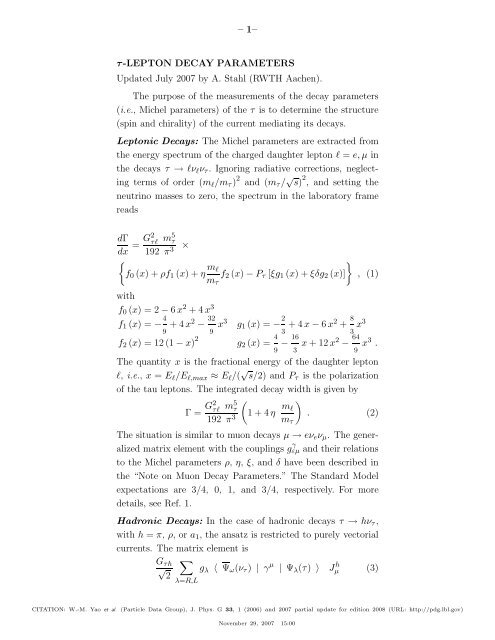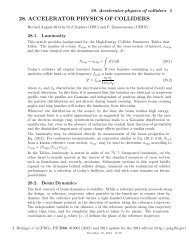tau-Lepton Decay Parameters - Particle Data Group
tau-Lepton Decay Parameters - Particle Data Group
tau-Lepton Decay Parameters - Particle Data Group
You also want an ePaper? Increase the reach of your titles
YUMPU automatically turns print PDFs into web optimized ePapers that Google loves.
–1–<br />
τ -LEPTON DECAY PARAMETERS<br />
Updated July 2007 by A. Stahl (RWTH Aachen).<br />
The purpose of the measurements of the decay parameters<br />
(i.e., Michel parameters) of the τ is to determine the structure<br />
(spin and chirality) of the current mediating its decays.<br />
<strong>Lepton</strong>ic <strong>Decay</strong>s: The Michel parameters are extracted from<br />
the energy spectrum of the charged daughter lepton ℓ = e, µ in<br />
the decays τ → ℓνℓντ. Ignoring radiative corrections, neglecting<br />
terms of order (mℓ/mτ ) 2 and (mτ / √ s) 2 , and setting the<br />
neutrino masses to zero, the spectrum in the laboratory frame<br />
reads<br />
dΓ<br />
dx = G2 τℓ m5τ 192 π<br />
�<br />
3 ×<br />
f0 (x)+ρf1 (x)+η mℓ<br />
with<br />
mτ<br />
�<br />
f2 (x) − Pτ [ξg1 (x)+ξδg2 (x)]<br />
, (1)<br />
f0 (x) =2− 6 x2 +4x3 f1 (x) =− 4<br />
9 +4x2 − 32<br />
9 x3 g1 (x) =− 2<br />
3 +4x − 6 x2 + 8<br />
3 x3<br />
f2 (x) =12(1−x) 2<br />
g2 (x) = 4 16<br />
−<br />
9 3 x +12x2− 64<br />
9 x3 .<br />
The quantity x is the fractional energy of the daughter lepton<br />
ℓ, i.e., x = Eℓ/Eℓ,max ≈ Eℓ/( √ s/2) and Pτ is the polarization<br />
of the <strong>tau</strong> leptons. The integrated decay width is given by<br />
Γ= G2 τℓ m5τ 192 π3 �<br />
1+4η mℓ<br />
�<br />
. (2)<br />
mτ<br />
The situation is similar to muon decays µ → eνeνµ. The generalized<br />
matrix element with the couplings g γ εµ and their relations<br />
to the Michel parameters ρ, η, ξ, andδ have been described in<br />
the “Note on Muon <strong>Decay</strong> <strong>Parameters</strong>.” The Standard Model<br />
expectations are 3/4, 0, 1, and 3/4, respectively. For more<br />
details, see Ref. 1.<br />
Hadronic <strong>Decay</strong>s: In the case of hadronic decays τ → hντ ,<br />
with h = π, ρ, ora1, the ansatz is restricted to purely vectorial<br />
currents. The matrix element is<br />
Gτh<br />
√2<br />
�<br />
λ=R,L<br />
gλ 〈 Ψω(ντ ) | γ µ | Ψλ(τ) 〉 J h µ (3)<br />
CITATION: W.-M. Yao et al. (<strong>Particle</strong> <strong>Data</strong> <strong>Group</strong>), J. Phys. G 33, 1 (2006) and 2007 partial update for edition 2008 (URL: http://pdg.lbl.gov)<br />
November 29, 2007 15:00
–2–<br />
with the hadronic current J h µ . The neutrino chirality ω is<br />
uniquely determined from λ. The spectrum depends only on a<br />
single parameter ξh<br />
dnΓ = f (�x)+ξhPτg (�x) , (4)<br />
dx1dx2 ...dxn<br />
with f and g being channel-dependent functions of the n<br />
observables �x =(x1,x2,...,xn) (see Ref. 2). The parameter ξh<br />
is related to the couplings through<br />
ξh = |g L| 2 −|g R| 2 . (5)<br />
ξh is the negative of the chirality of the τ neutrino in these<br />
decays. In the Standard Model, ξh = 1. Also included in the<br />
<strong>Data</strong> Listings for ξh are measurements of the neutrino helicity<br />
which coincide with ξh, if the neutrino is massless (ASNER<br />
00, ACKERSTAFF 97R, AKERS 95P, ALBRECHT 93C, and<br />
ALBRECHT 90I).<br />
Combination of Measurements: The individual measurements<br />
are combined, taking into account the correlations between<br />
the parameters. In a first fit, universality between the two<br />
leptonic decays, and between all hadronic decays, is assumed.<br />
A second fit is made without these assumptions. The results<br />
of the two fits are provided as OUR FIT in the <strong>Data</strong> Listings<br />
below in the tables whose title includes “(e or mu)” or “(all<br />
hadronic modes),” and “(e),” “(mu)” etc., respectively. The<br />
measurements show good agreement with the Standard Model.<br />
The χ 2 values with respect to the Standard model predictions<br />
are 24.1 for 41 degrees of freedom and 26.8 for 56 degrees of<br />
freedom, respectively. The correlations are reduced through this<br />
combination to less than 20%, with the exception of ρ and η<br />
which are correlated by +23%, for the fit with universality and<br />
by +70% for τ → µνµντ .<br />
Model-independent Analysis: From the Michel parameters,<br />
limits can be derived on the couplings gκ ελ without further<br />
module assumptions. In the Standard model gV LL = 1 (leptonic<br />
decays), and gL = 1 (hadronic decays) and all other couplings<br />
vanish. First, the partial decay widths have to be compared<br />
to the Standard Model predictions to derive limits on the<br />
November 29, 2007 15:00
–3–<br />
normalization of the couplings Ax = G 2 τx /G2 F<br />
constant GF :<br />
Ae =1.0012 ± 0.0053 ,<br />
Aµ =0.981 ± 0.018 ,<br />
with Fermi’s<br />
Aπ =1.018 ± 0.012 . (6)<br />
Then limits on the couplings (95% CL) can be extracted (see<br />
Ref. 3 and Ref. 4). Without the assumption of universality, the<br />
limits given in Table 1 are derived.<br />
Table 1: Coupling constants g γ εµ. 95% confidence<br />
level experimental limits. The limits include<br />
the quoted values of Ae, Aµ, andAπ and<br />
assume Aρ = Aa1 =1.<br />
τ → eνeντ<br />
|g S RR | < 0.70 |gV RR | < 0.17 |gT RR |≡0<br />
|gS LR| < 0.99 |gV LR| < 0.13 |gT LR| < 0.082<br />
|gS RL | < 2.01 |gV RL | < 0.52 |gT RL | < 0.51<br />
|gS LL| < 2.01 |gV LL| < 1.005 |gT LL| ≡0<br />
τ → µνµντ<br />
|gS RR| < 0.72 |gV RR| < 0.18 |gT RR| ≡0<br />
|gS LR | < 0.95 |gV LR | < 0.12 |gT LR | < 0.079<br />
|gS RL| < 2.01 |gV RL| < 0.52 |gT RL| < 0.51<br />
|gS LL | < 2.01 |gV LL | < 1.005 |gT LL |≡0<br />
τ → πντ<br />
|g V R | < 0.15 |gV L<br />
τ → ρντ<br />
|g V R | < 0.10 |gV L<br />
τ → a1ντ<br />
|g V R | < 0.16 |gV L<br />
| > 0.992<br />
| > 0.995<br />
| > 0.987<br />
November 29, 2007 15:00
–4–<br />
Model-dependent Interpretation: More stringent limits can<br />
be derived assuming specific models. For example, in the framework<br />
of a two Higgs doublet model, the measurements correspond<br />
to a limit of m H ± > 1.9 GeV× tan β on the mass of the<br />
charged Higgs boson, or a limit of 253 GeV on the mass of the<br />
second W boson in left-right symmetric models for arbitrary<br />
mixing (both 95% CL). See Ref. 4 and Ref. 5.<br />
Footnotes and References<br />
1. F. Scheck, Phys. Reports 44, 187 (1978);<br />
W. Fetscher and H.J. Gerber in Precision Tests of the<br />
Standard Model, edited by P. Langacker, World Scientific,<br />
1993;<br />
A. Stahl, Physics with τ <strong>Lepton</strong>s, Springer Tracts in Modern<br />
Physics.<br />
2. M. Davier et al., Phys. Lett. B306, 411 (1993).<br />
3. OPAL Collab., K. Ackerstaff et al., Eur. Phys. J. C8, 3<br />
(1999).<br />
4. A. Stahl, Nucl. Phys. (Proc. Supp.) B76, 173 (1999).<br />
5. M.-T. Dova et al., Phys.Rev.D58, 015005 (1998);<br />
T. Hebbeker and W. Lohmann, Z. Phys. C74, 399 (1997);<br />
A. Pich and J.P. Silva, Phys. Rev. D52, 4006 (1995).<br />
November 29, 2007 15:00



